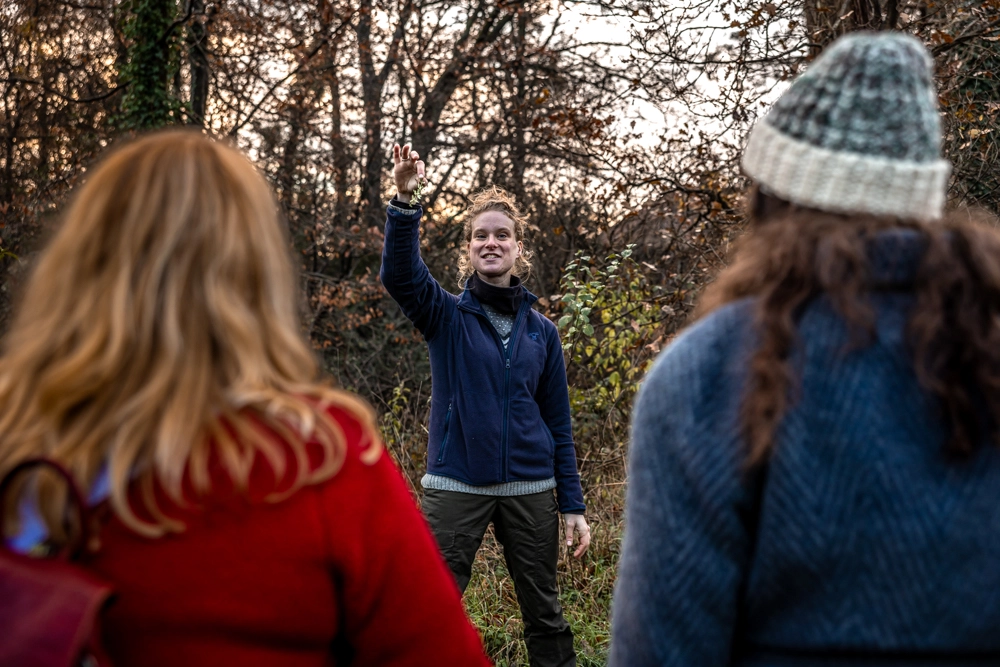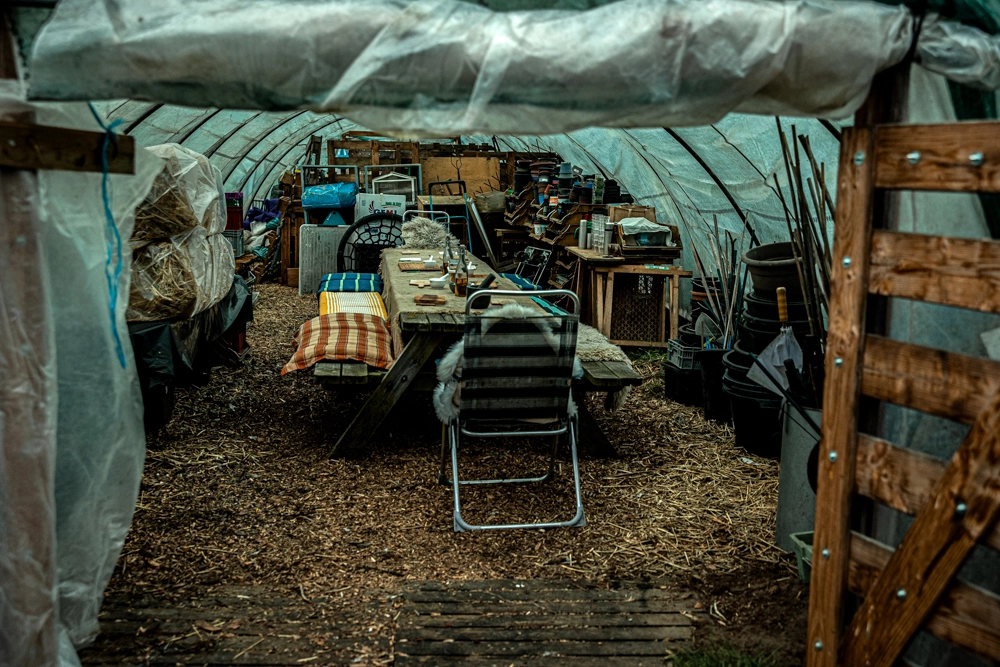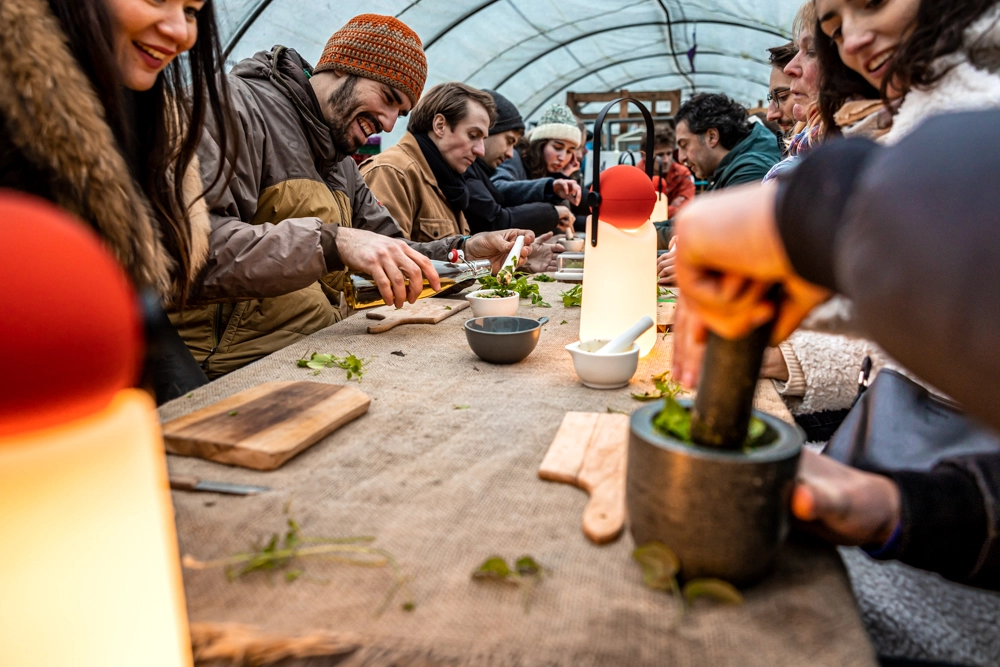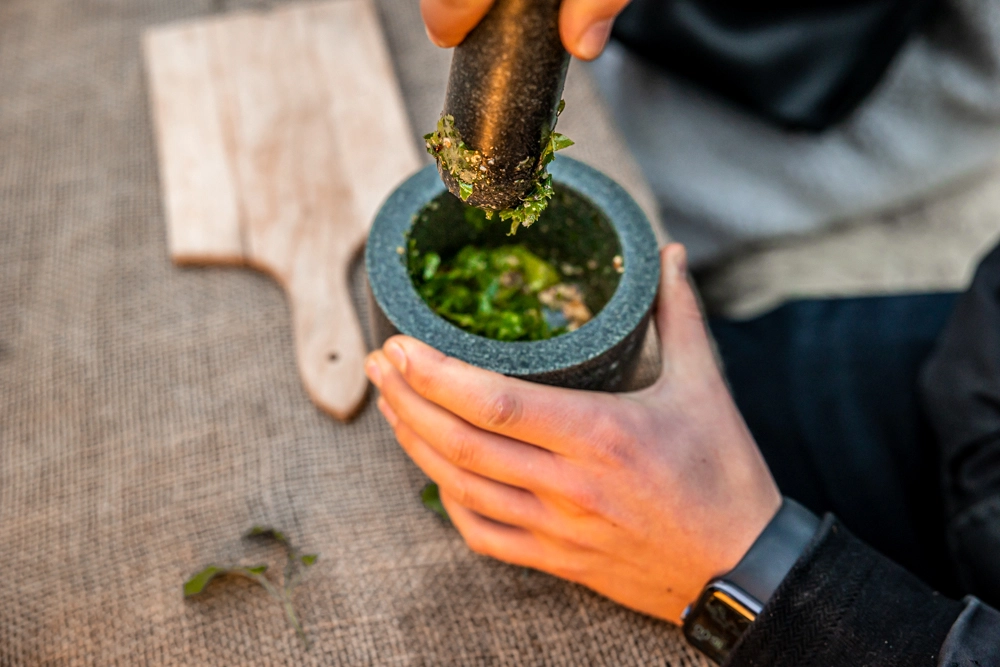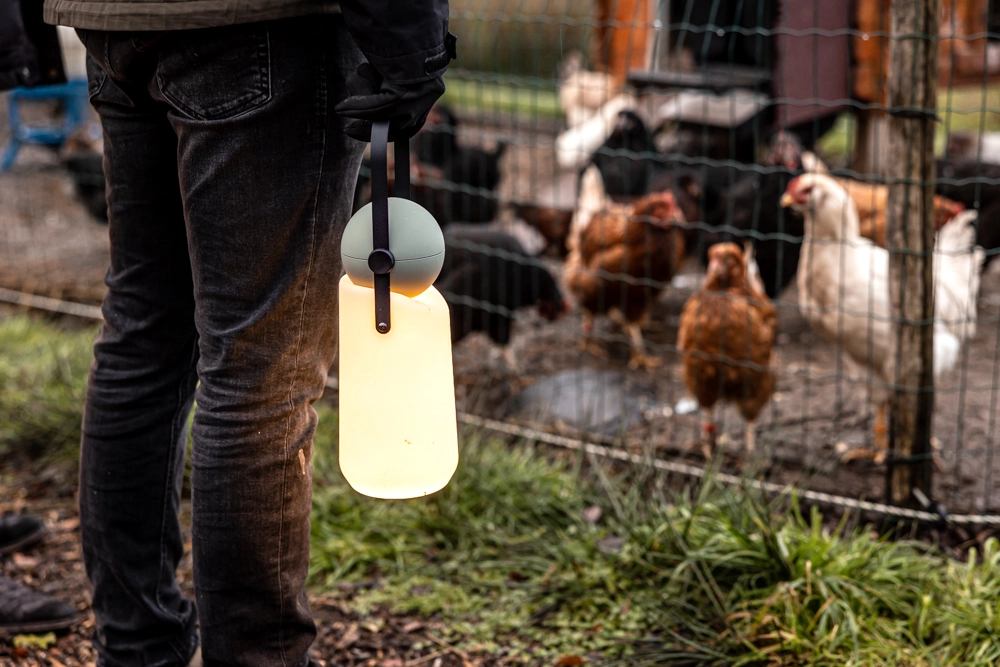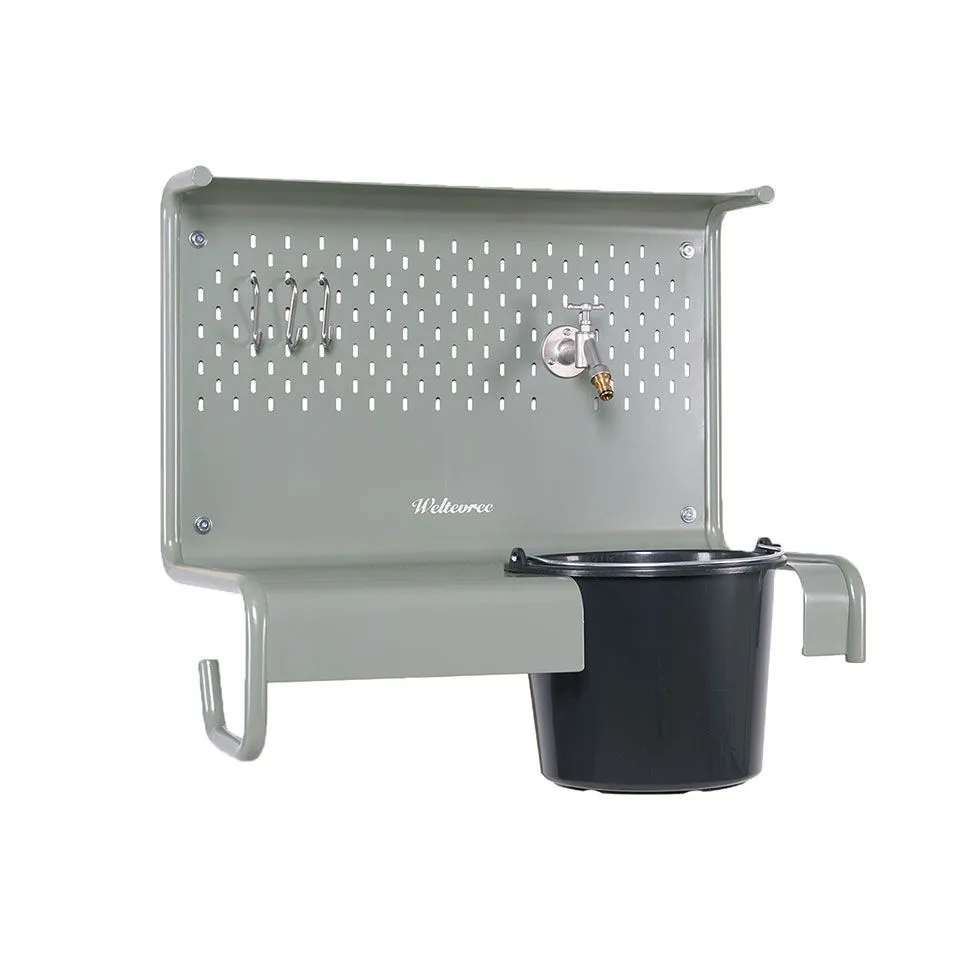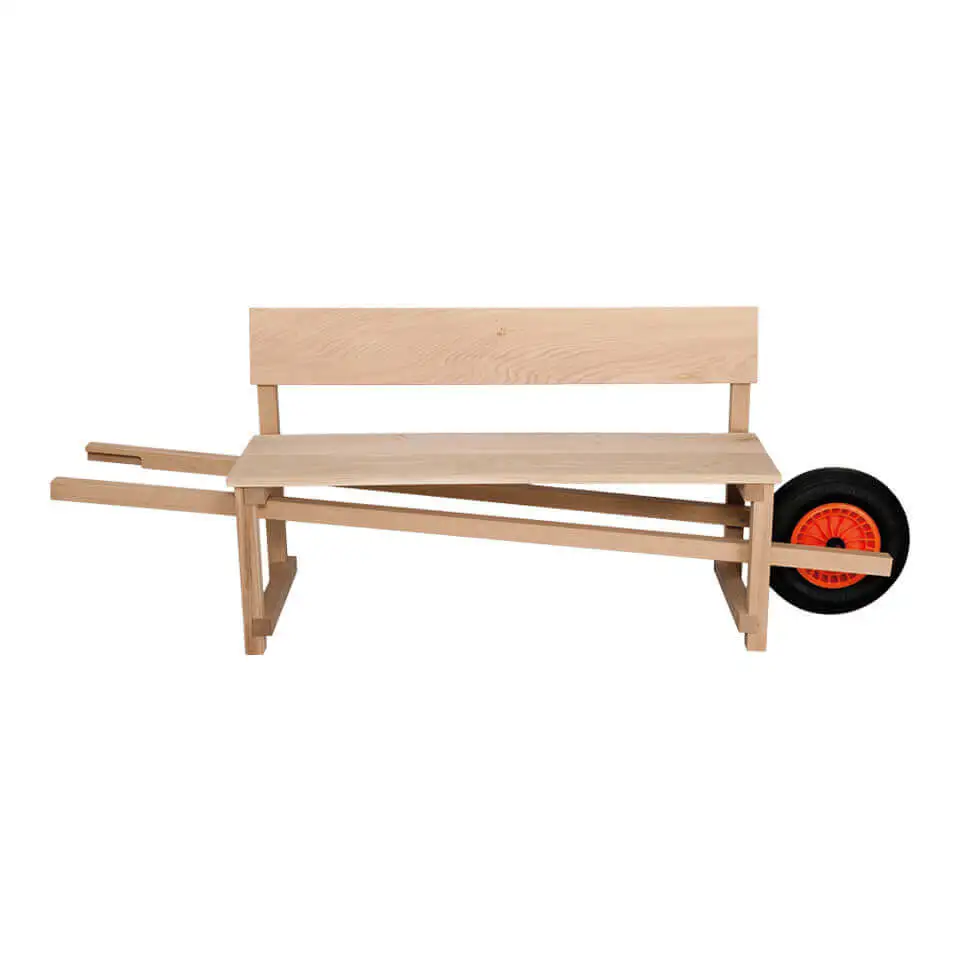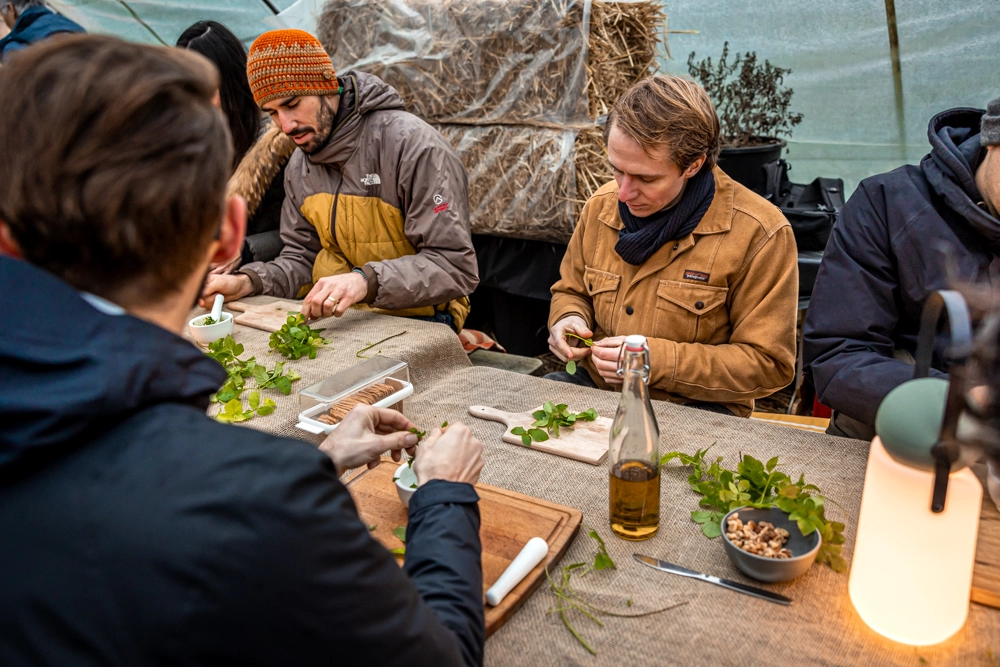
What foraging can teach you about life
It is an early morning and I am walking through a sunlit forest in Den Dolder, The Netherlands. The frosty air tingles my nose and eyes and the frost glitters on the evergreen firs and plants that are still hibernating. 'Look, a deer walked here just recently.' Fresh tracks can be seen on the dark forest floor. I am wandering through the forest with Mirjam van der Laan, who is the creative behind the organization ‘Natuurbeleving de Boomklever’ with which she organizes wild-picking workshops for both children and adults in the Netherlands. During the two hours we walk around in the forest, she is teaching me the basics of foraging: what plants can you forage? In what places? Is it dangerous and maybe even most important, what can you make with your harvest? But as we talk, I notice that foraging is about much more than what nature offers us in terms of edible plants. We talk about education, biology and nostalgia for a place or time that no longer exists. Foraging, in essence, is about the wonder of discovery, the relationship between man and nature, and the feeling that although you have not done this before, you still experience a token of recognition.
Foraging: the longer you look, the more you see
In the Netherlands, only a small percentage of 15% can be marked as nature. Wherever you walk, you can usually hear the roar of a highway in the not-too-distant distance. Fortunately, we don't need much nature to be able to forage in the wild. 'What often surprises people the most when they come along on a wild-picking walk, is that so many edible greens grow on such a small piece of land. These are things you normally overlook, simply because you don't know. But when you look closely, you see all kinds of things growing in a small patch of nature: ground elder in the roadside, nettles at the edge of the woods, wild blackberries, or a judas ear (a slimy mushroom, ed.) growing against a beech tree. The longer you look, the more you see'. As the forest floor crunches under our feet, Mirjam explains the basics of foraging.. 'The most important rule of foraging is that you do it with respect for nature. Don't pick too much and make sure there is always enough left for others and all the critters in the forests - after all, we are not alone in nature. Birds, insects, deer and other animals also eat from the plants we pick. By law, foraging is prohibited in The Netherlands, but it is tolerated as long as you don't pick more than one little basket per person. Take nettle for example, a very nice plant to pick. It's packed with vitamin C and is just incredibly delicious. I make soup from it, put it in a savory pie or make nettle chips. Nettle often grows together in large quantities, so you can pick quite a bit. But for example a plant that stands on its own, we don't forage and leave it be. I have a feeling of amazement during our walk, never before have I considered that so many of the little plants I mistook for weeds are not only edible, but also quite delicious. We pick a few nettle leaves and rub off the stinging hairs, and then we taste. The taste is peppery, spicy and slightly nutty. 'Near nettle often grows sorrel, plantain, or dogstraw. The juice from these little plants soothes the stinging sensation of the nettle. And they're all edible, too. How cool is it that nature arranges itself that way?
The second rule of foraging: know what you're picking! Many plants that are edible have a look-a-like that is heartily poisonous. So never eat anything if you're not 100 percent sure what you're picking, and use a determination book (book for recognizing plants, ed.) to identify a plant or shrub. 'Take hogweed, for example: a very unusual plant whose sap most people do know can cause nasty burns. But the leaves and stems of a young hogweed are edible, as are the young flower buds and seeds. Its taste is so special: it is a combination between cucumber, tangerine, celery and coconut. Where can you find a taste like that in your local supermarket?'
'Foraging is about the wonder, that you get a thrill from the unexpected things you encounter.'
Learning by exploring
When Mirjam was working as a commercial studies teacher several years ago, she found that she preferred to teach outside the four walls of her classroom. "I saw my students sitting still in their chairs for hours, taking in more and more information, and I saw that it wasn't working. I'm a doer and so were my students. So I sent them out, visiting companies, interviewing people, and doing research. This inquiry-based learning method worked much better. From her interest in nature, Mirjam began a two-year course to become a nature guide. 'As a child I used to be so happy to be surrounded by nature. I preferred swimming, for example in the outdoors. Rain or shine, I could be found in the water. That same joy and wonder I felt as a child, I still feel when I am in nature. During my nature guide training, when I was studying a miniature plant with my knees in the mud with a magnifying glass, everything fell into place. I felt so happy. By going into nature by herself with a determination book, Mirjam learned all about edible plants, shrubs and trees. 'I loved noticing how quickly you get lost in a small piece of nature while foraging, to
getting completely immersed in nature. I had such an intrinsic motivation to learn, that it felt like second nature to me. Compulsory learning in school is often very difficult, whereas if you really really enjoy something, you soak up the knowledge like a sponge. I learned by doing: by tasting, cooking, and experiencing. There is no better way to learn.'
During the foraging walks Mirjam gave to the children at the day care center where she worked at the time, she noticed that not only were the children enthusiastic, but their parents in particular were fascinated as well. 'Fathers and mothers pushed their own children away so they could see and hear what I was telling them. It is so nice to see adults experiencing a little of that childlike enthusiasm. Because even adults don't know all that is going on around them in nature.
'Fathers and mothers pushed their own children away to see what was growing.'
From survival to luxury
It's an interesting evolution. People used to be hunters and gatherers. Knowledge about which plants, shrubs and trees were edible was not only widespreadly known, but a necessity to be able to survive. Even later, when people were already living in settlements, magnolia syrup was a primary source of vitamin C. And ground elder, a small green "weed" from which you can make delicious pesto, for example, was brought by the Romans, for whom it was an important part of their diet. Meanwhile, all that common knowledge has been lost, because who can still tell whortleweed from spotted hemlock? "Nature has become a kind of park that we visit. We recreate: we hike, picnic or go mountain biking. But nature no longer feels like ours; we no longer feel connected to nature. We see greenery and trees and we can tell that it is beautiful, but we have no idea what is growing around us and how much we can do with it.'
If you think about it, we are still hunters and gatherers, we just replaced nature with supermarkets. Spending real time in nature is a luxury these days. We go to nature to relax and feel connected, and that ‘moment’ is a luxury in your busy daily life. Nature has become an in-between place. As a society, we have forgotten that nature was our home. Now we are only outside when we are on the road. From home to school, from work to the supermarket. “That's actually a terrible shame. Because who doesn't love to be outside? It is known that nature has a healing effect and that it works against depression and burnout. We become happy from being in nature, but we have become so far removed from it that we have forgotten that.”
'Spending real time in nature is a luxury these days. We're only outside when we're on the road.'
Experiencing nature with full focus
For Mirjam, wildflower picking is a way to feel at one with nature again. 'When I walk through nature, I still have a lot of thoughts. But when I'm foraging, my head is empty. You're so focused that it's practically impossible to think about other things. And you get to know nature so much better than when you walk through it alone. You look differently, your eyes become sharper. If you're looking for a mushroom, it's very difficult to look for another plant at the same time. And you learn to read the landscape. She points to the patch of forest in front of us. 'Look, you can see it's hilly here. There is sandy soil and there are pines and firs growing. Then you know: this is probably where a large sponge mushroom, grows, because it likes sandy soil and conifers.'
Not only reading the landscape will show you where to find the best edible plants, don't forget to also look for wild animals. They will give away in their own way as well where you are most likely to be able to find edible plants. If you keep your eyes open and know what to look for, you can see, for example, the switchbacks, small paths between the vegetation that deer use. Or you can recognize the bushes and mushrooms they eat from. And, of course, the tracks animals leave on the earth. 'So you see: I share this forest with the animals. For me, that is foraging. Knowing that you share nature with everything that lives there and realizing that we are all part of this circle, that we are all connected. That primitive, that basic, that's what makes us so happy about nature. It is liberating, and gives relief. Because by looking at it that way, everything else becomes less important. Everything we worry so much about in life suddenly matters less. The stress at work, whether your kids are going to the right school, whether your colleagues like you. When we are in nature, we are just being human. And sometimes just being ‘here’ is enough.' It reminds me of an old English word, Dustscaewung, which means as much as contemplating that dust has been other things - the walls of a city, a book, a deer or an ancient tree - the realization that we all come from the same place and return to the same thing: dust.
'That to me is wildflower picking: the primitive, the basic. Knowing that you share nature with everything that lives there and realizing that we are all part of each other, all connected.'
Create your own wild-picking wonderland
Now anyone who thinks you have to live in the woods or in the middle of the meadows to be able to forage is wrong. In the middle of the forest there is actually little to find: because there is so much shade, little can grow. In a clearing or around the edges of an open field, you are more likely to find something edible. But you can also forage in the middle of town. In city parks you can find anything: walnut trees, wild blackberries, ground elder under a bush, nettles on the roadside. There are even apps where avid foragers mark places where there is something to pick. And, of course, you can always let your own backyard go wild. 'At least half of my garden is edible. I have created a food forest in my own garden with Japanese wineberry, blueberries, blackberries, strawberries and raspberries. But there are also countless edible plants that have traveled by, for example the wind into my garden. For example, ground elder: a real proliferator so people often remove it, but you make delicious pesto from it. Or shepherd's purse, a plant with a cute little white flower that is often seen as a weed. It tastes like watercress and is hearty in salads. Garlic-less garlic is a very familiar one, grows everywhere and tastes like garlic. When I come across these little plants in my garden I think, 'hey, welcome to my garden.' So the next time you come across weeds in your garden, don't just pull them out of the ground. Who knows, you might be able to make something delicious with it.
At Mirjam's place, wildflower foraging is on the menu every week. I don't have a favorite recipe, the best thing about cooking with items I forage from nature, is seeing what you find and being creative in what you can make with it. The possibilities really are endless. Many edible plants you can use as seasonings, just like you use parsley or basil. Other plants can be used like you eat spinach: stir-fried, through a curry, in a soup or salad. From all kinds of small plants you can easily make a delicious pesto. Last week I made shoarma with wild oyster mushrooms. From Judas ear, a slimy mushroom, I made a Japanese noodle soup. And on a shelf in the basement, a bottle of pine needles is fermenting into vodka. I always try to come up with something different every time.
Take good care of the earth and take good care of yourself
Foraging is also a lot healthier than supermarket fruits and vegetables. Both for humans and the earth: not only because it doesn't require pesticides, food miles, and heated greenhouses, but also because food from nature contains far more nutrients. So there are far more nutrients in wild-picked foods. But beware: your stomach might be a little less happy with the wild harvest than you are, as it has to get used to the large amount of nutrients.
Do you want to go foraging yourself? Then we encourage you to do some research before you head out. There are numerous websites, books and other references you can use to prepare yourself. This way you will know what you need to get started, how to avoid picking a poisonous plant and what special and delicious recipes you can make with it. Take us along all your adventures using #worldofweltevree.

